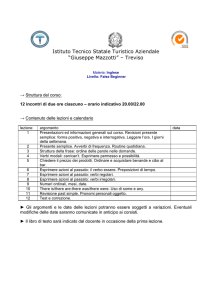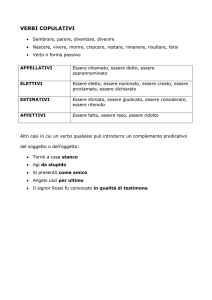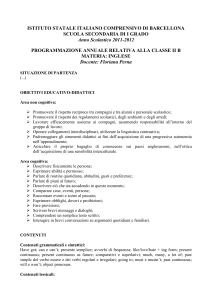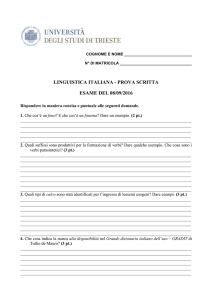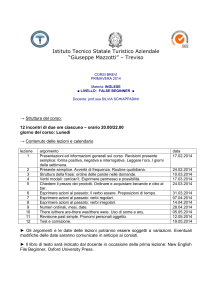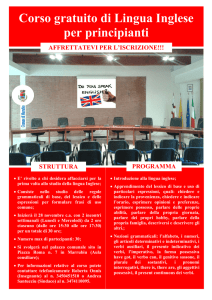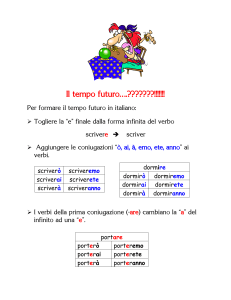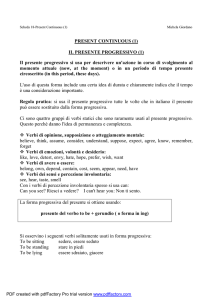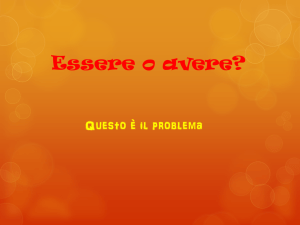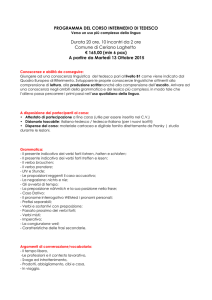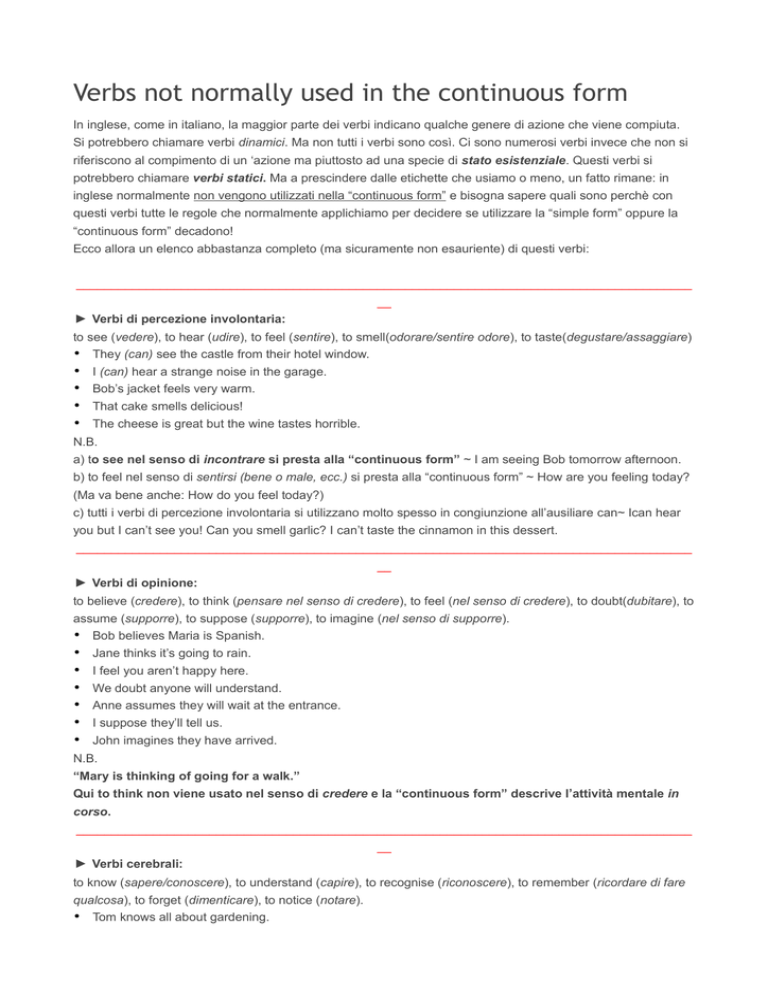
Verbs not normally used in the continuous form
In inglese, come in italiano, la maggior parte dei verbi indicano qualche genere di azione che viene compiuta.
Si potrebbero chiamare verbi dinamici. Ma non tutti i verbi sono così. Ci sono numerosi verbi invece che non si
riferiscono al compimento di un ‘azione ma piuttosto ad una specie di stato esistenziale. Questi verbi si
potrebbero chiamare verbi statici. Ma a prescindere dalle etichette che usiamo o meno, un fatto rimane: in
inglese normalmente non vengono utilizzati nella “continuous form” e bisogna sapere quali sono perchè con
questi verbi tutte le regole che normalmente applichiamo per decidere se utilizzare la “simple form” oppure la
“continuous form” decadono!
Ecco allora un elenco abbastanza completo (ma sicuramente non esauriente) di questi verbi:
________________________________________________________________________________________
__
► Verbi di percezione involontaria:
to see (vedere), to hear (udire), to feel (sentire), to smell(odorare/sentire odore), to taste(degustare/assaggiare)
• They (can) see the castle from their hotel window.
• I (can) hear a strange noise in the garage.
• Bob’s jacket feels very warm.
• That cake smells delicious!
• The cheese is great but the wine tastes horrible.
N.B.
a) to see nel senso di incontrare si presta alla “continuous form” ~ I am seeing Bob tomorrow afternoon.
b) to feel nel senso di sentirsi (bene o male, ecc.) si presta alla “continuous form” ~ How are you feeling today?
(Ma va bene anche: How do you feel today?)
c) tutti i verbi di percezione involontaria si utilizzano molto spesso in congiunzione all’ausiliare can~ Ican hear
you but I can’t see you! Can you smell garlic? I can’t taste the cinnamon in this dessert.
________________________________________________________________________________________
__
► Verbi di opinione:
to believe (credere), to think (pensare nel senso di credere), to feel (nel senso di credere), to doubt(dubitare), to
assume (supporre), to suppose (supporre), to imagine (nel senso di supporre).
• Bob believes Maria is Spanish.
•
•
•
•
•
•
Jane thinks it’s going to rain.
I feel you aren’t happy here.
We doubt anyone will understand.
Anne assumes they will wait at the entrance.
I suppose they’ll tell us.
John imagines they have arrived.
N.B.
“Mary is thinking of going for a walk.”
Qui to think non viene usato nel senso di credere e la “continuous form” descrive l’attività mentale in
corso.
________________________________________________________________________________________
__
► Verbi cerebrali:
to know (sapere/conoscere), to understand (capire), to recognise (riconoscere), to remember (ricordare di fare
qualcosa), to forget (dimenticare), to notice (notare).
• Tom knows all about gardening.
•
•
•
•
•
We understand him when he speaks slowly.
I recognise the people in this photo.
Clare usually remembers to buy the bread.
Peter often forgets to brush his teeth.
I notice the museum is open today.
________________________________________________________________________________________
__
► Verbi di sentimenti e desideri:
to love (amare), to like (piacere), to dislike (non piacere), to hate (odiare), to want (volere),to prefer(preferire), to
regret (rimpiangere), to fear (temere), to hope (sperare).
• She loves walking in the evening.
•
•
•
•
•
•
•
•
They like hot chocolate in the evening.
His mother dislikes his new girlfriend.
Bob hates doing the shopping.
Anne wants to travel all over the world.
David prefers to work in the evenings.
I regret not selling the house last year.
He fears she won’t come back.
Steve hopes to learn English quickly.
________________________________________________________________________________________
__
► Verbi di misura e contenimento:
to measure (misurare usato in modo intransitivo), to cost (costare), to weigh (pesare), to contain (contenere),to
hold (tenere nel senso di contenere).
• The wardrobe measures 2m by 2m.
• This watch costs £150.
• The baby weighs 3kg.
• This box contains all my photographic equipment.
• These bottles hold about 1/2 a litre of wine each.
N.B.
“Tom is measuring the garage.”
Qui to measure viene usato in modo transitivo (con un complemento oggetto) e la “continuous form”
descrive l’attività in corso.
________________________________________________________________________________________
__
► Verbi di possesso:
to have(avere), to own (possedere),to possess (possedere).
• Bob and Jane have(got) a small house in London.
• Jack owns all the houses in this street.
• Simon possesses a lot of land in the south of France.
N.B.
“Bob is having breakfast.”
Qui to have non è usato nel senso di possesso ma come un verbo dinamico e la “continuous form”
descrive l’attività in corso.
________________________________________________________________________________________
__
► Verbi di apparenza:
to seem (sembrare),to look / to look like (nel senso di sembrare/assomigliare).
• She seems to be very happy with her new job.
• That book looks interesting.
• John looks like his father.
________________________________________________________________________________________
__
► Il verbo ‘to be’:
• Sam is here.
N.B.
“John is being very silly.”
Qui to be viene usato nel senso di comportarsi e la “continuous form” descrive il comportamento in corso.

